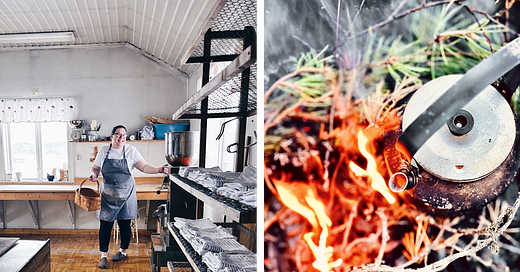Bonjour from The Bakers' Cottage
The dough is resting, the oven is warm – something new is coming.
Hello! I’m Fanny, a French pastry chef and food writer based in the far north of Sweden, where I live with my partner, Karl, and our daughter, Sienna.
It’s been a long way to the arctic circle – one that started with a classic training in some of the best pâtisseries in France and led through Michelin-starred restaurant kitchens in London. After a childhood in the south of France – flying kites on the beach, sitting on the kitchen counter watching my grand-mère bake madeleines, and earning a master’s degree in food science and agronomy – I fell in love with Sweden. Winters that stretch long and slow, and summers that barely sleep.
And just like that, I called Skellefteå home.
These days, I split my time between running the kitchen at Bryggargatan – highlighted in TIME magazine for its “Michelin-caliber Nordic cuisine plated without pretension” – hosting baking retreats, and writing about the things that matter most to me. My work is rooted in both precision and nostalgia – understanding the science behind a perfect croissant, while knowing that the best pastries often start with a story.
There’s always butter on the counter, flour on my apron, and a rolling pin within reach.
Glad you’re here!
The Bakers’ Cottage
Every farm once had a bakers’ cottage [bagarstuga]. A small wooden house built for baking, used twice a year – once in spring, when the water mills thawed and the first flour of the season could be milled, and again in autumn, after the harvest.
The baking stretched over days. Tunnbröd and knäckebröd, rolled, pricked, baked, then left to dry on straw-covered floors or hung from wooden poles near the ceiling – enough to last until the oven was fired again.
Mjukkaka, a soft bread found only in Lapland, was different. Made in small batches, kneaded with a handful of precious wheat flour – bought, as it couldn’t be grown this far north. Saved for special occasions. Baked when guests arrived, or when there was something to celebrate.
Some bagarstugor stand empty now, their ovens cold.
But for me, they are something more.
Between the warmth of the fire and the birch-bench worn smooth by time, the soft hum of the dough mixer and the scent of pine logs burning down to embers – it is my happy place.
A space where time slows, where the work is steady and familiar, where stories and recipes are shared in the quiet between batches.
How I develop my recipes
Every recipe starts with an idea. A memory, a flavour, a texture I can almost taste before it exists. Sometimes it’s a childhood favourite, like the butter-crisp edges of my grand-mère’s clafoutis.
Other times, it’s a question – what would krämbullar taste like if I filled them with confiture de lait made with the creamiest milk, from a local farm, where Pär and Johanna raise cows overlooking the lake of Storkågeträsk, and make prized cheeses and dairy?
From there, I work backwards. I break things down – flour ratios, hydration levels, sugar’s effect on texture. I consider tradition, but I also ask: What if? What if I used golden caster sugar instead of white? What if I infused the milk with smoked hay? What if I borrowed a technique from classical French pâtisserie and applied it to Swedish baking?
I rely on science as much as intuition. Some recipes are built on meticulous research – adjusting ratios, hydration percentages, comparing fermentation techniques.
Others start in the archives, deep in folklore collections, browsing hundreds of neatly handwritten or printed cards, each one a glimpse into the traditions of those who baked before us.
And sometimes, a recipe is simply that – a craving, a quiet afternoon in the kitchen.
It’s a balance.
Some recipes take months to perfect. Others come together on the first try, as if they were always meant to be. Either way, I write everything down – that is, when I don’t forget. Often, just the grams and temperatures.
Because in the end, a recipe isn’t just about ingredients – it’s about capturing a moment, a place, a feeling. And that’s what I hope to share here, with you.







So beautiful